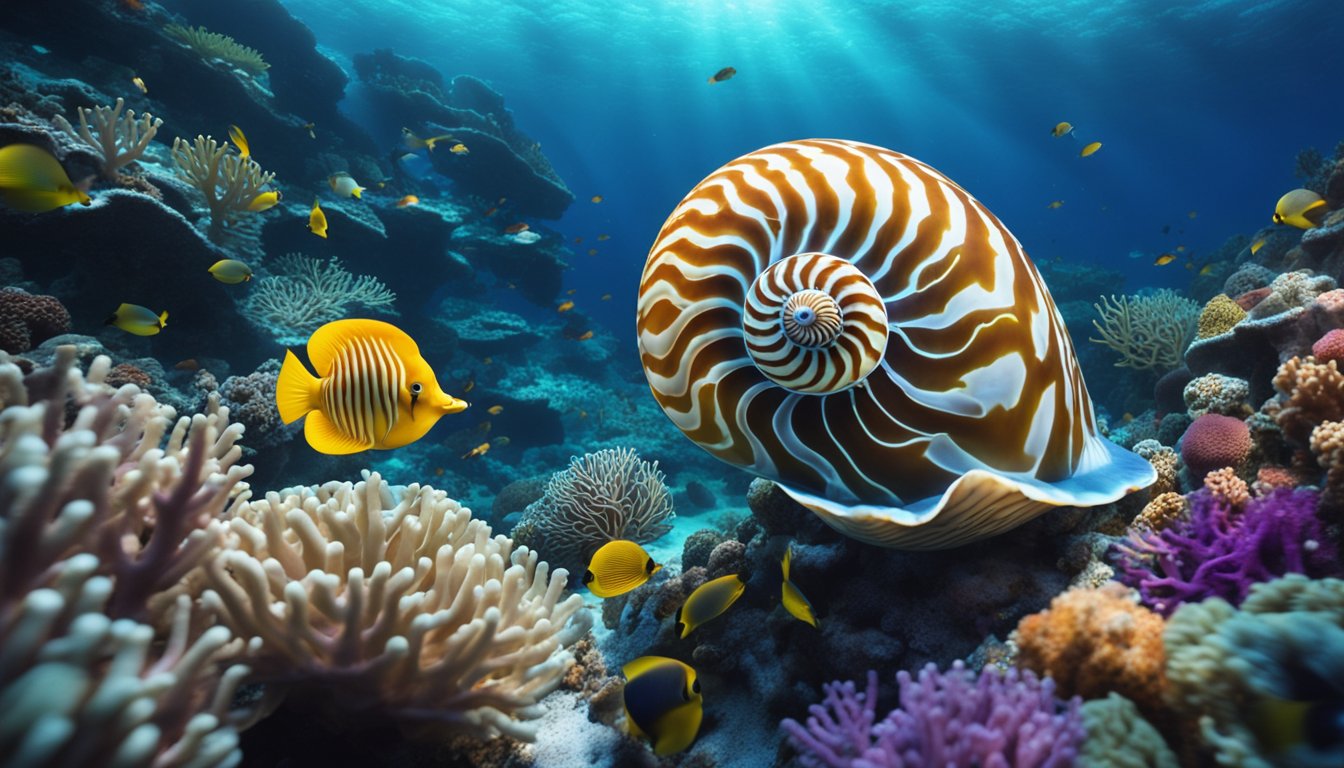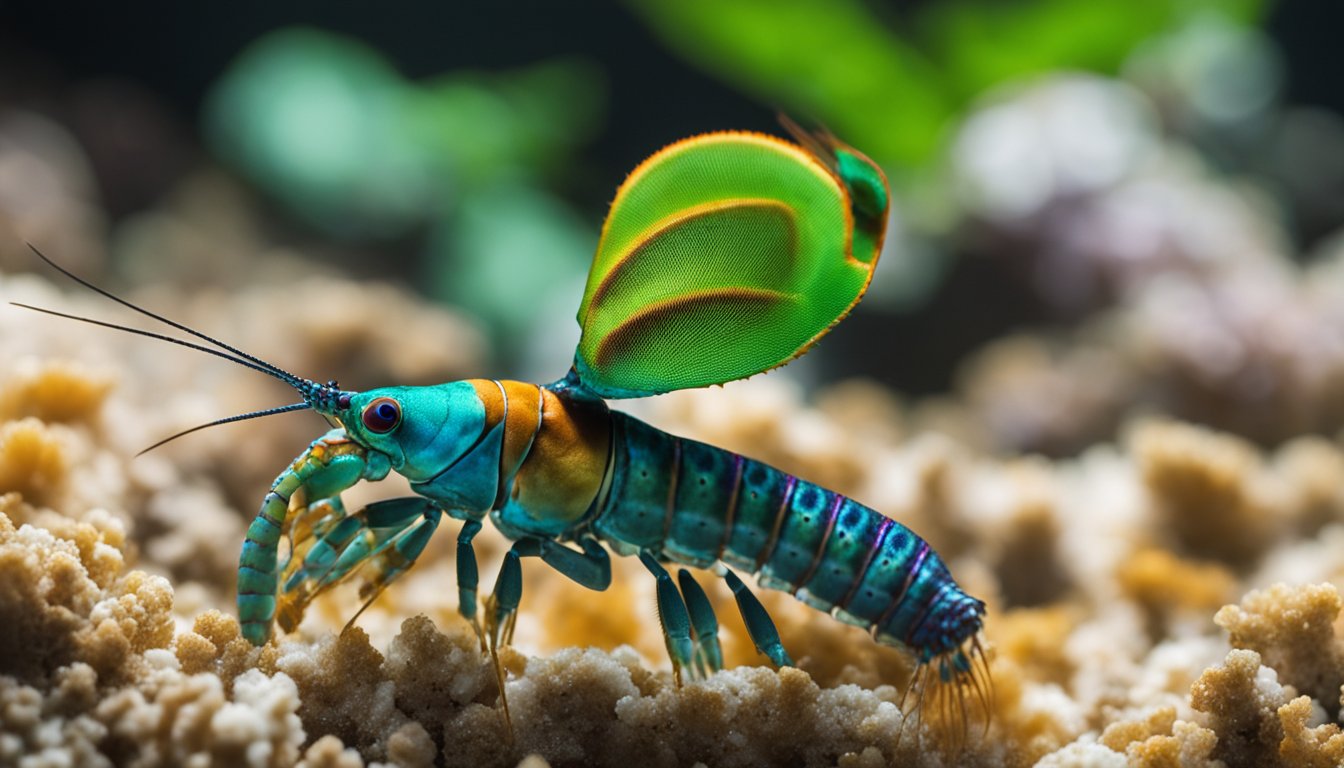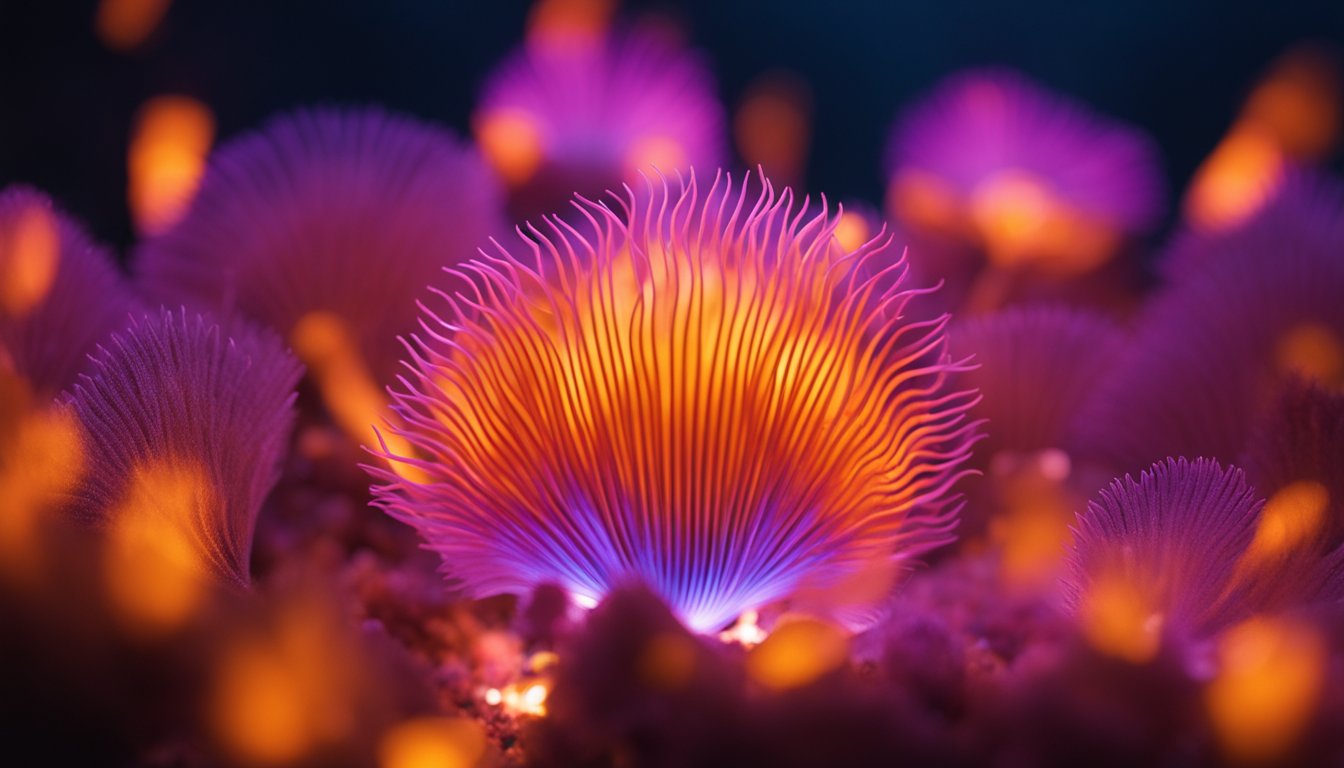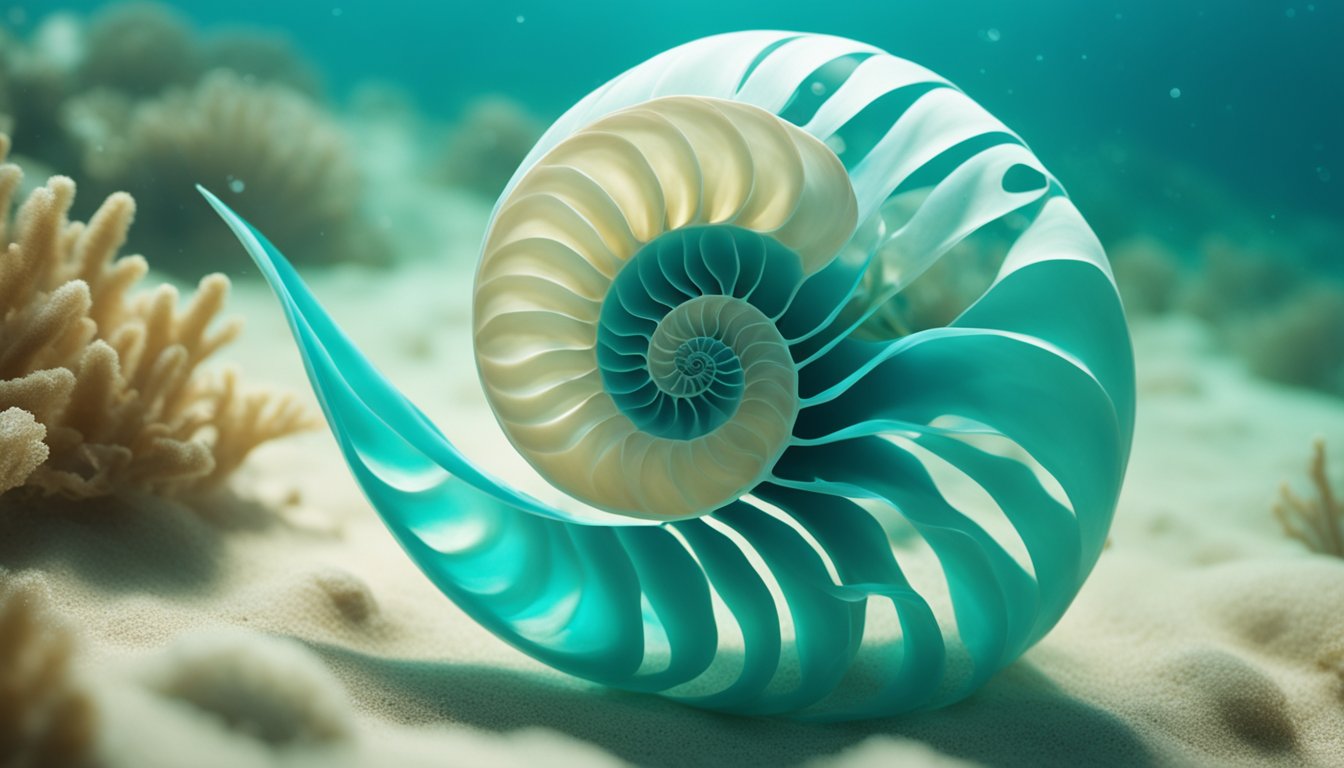Imagine diving deep into the ocean, gliding past coral reefs and schools of fish until you meet a creature that’s a living time capsule from the deep past.
We call this marvelous mollusk the chambered nautilus.
These sea-dwellers have been around for hundreds of millions of years, and their relatives used to rule the ancient seas.
Looking at a chambered nautilus is like peeking through a window straight into prehistory!

The chambered nautilus is famous for its beautiful spiral shell divided into chambers.
As it grows, it adds new chambers to its shell, and each one tells a story of its life. Just think of it as a floating diary!
These creatures use their shells not just for protection but also for buoyancy, allowing them to float up and down in the ocean like little submarines.
Isn’t it fascinating that their home is also their mode of transport?
We can learn a lot about the health of our oceans by studying these curious animals.
Chambered nautiluses are sensitive to changes in the water, like temperature and acidity, which are big clues for us about the condition of their underwater world.
By getting to know our shelled friends and their habitat, we’re also uncovering the secrets of our planet’s past and how to protect its future.
So, let’s strap on our imaginary scuba gear and explore the life of the chambered nautilus together!
Discovering the Chambered Nautilus

As we journey into the depths of the ocean, let’s uncover the mysteries of the chambered nautilus, an ancient creature whose design has remained unchanged for millions of years.
What Is a Chambered Nautilus?
The chambered nautilus is a marine mollusk that enchants us with its beautifully spiraled shell.
Picture a snail with a shell that could easily win a grand design award!
This isn’t your average seashell though; its interior is a marvel of nature’s engineering. Each shell is sectioned into chambers.
As the nautilus grows, it builds new chambers, sealing the old ones behind it.
This clever creature can adjust the gas and liquid in these chambers to help it float or dive in the water. Imagine having your own built-in submarine!
The Secret Life of a Living Fossil
Calling the chambered nautilus a “living fossil” is like saying it’s a time traveler from the ancient seas.
These creatures have been gliding through the deep for around 500 million years. That’s way before the dinosaurs!
Their ancestors mingled with some of the most mysterious creatures that we can only dream of now. It’s incredible, isn’t it?
Even though they’re old in the history books, nautiluses have kept their lifestyle a secret.
They spend most of their time in the deep, dark ocean, coming up to shallower waters at night to snack on shrimp and fish.
These quiet, bashful relatives of squid don’t like the spotlight, but when they do come close to the surface, it’s our chance to learn and marvel at these living antiques.
Time Travelers of the Sea

Imagine setting sail on a grand adventure across the vast ocean, not on a ship but within the spiraled shell of a chambered nautilus.
Together, we’re about to peek into their incredible journey through time!
Nautilus: A Journey Through Millions of Years
The chambered nautilus, with its distinctive shell, has been navigating the deep sea for more than 500 million years.
That’s right, friends, these marine animals have been around since before the dinosaurs!
We’re talking about a creature that has witnessed the shifting of continents and the rise and fall of entire species.
Isn’t it amazing to think that when we look at a nautilus, we’re essentially seeing a living fossil?
The nautilus belongs to a group called cephalopods, which includes squids, octopuses, and cuttlefish.
Unlike its cousins, it has barely changed over the ages.
It’s as if the nautilus found a design that worked really well and stuck with it – like your favorite pair of sneakers that you never want to throw away.
Their persistence through time gives us an extraordinary glimpse into a past that is long gone, helping us understand our planet’s evolutionary history.
Understanding the Nautilus Spiral
Now, let’s zoom in on what makes the nautilus shell so special: the spiral.
This isn’t just any sort of spiral; it’s a logarithmic spiral, meaning it gets wider (or further from the center) with each turn, but at a constant rate.
It’s a pattern you’ll find all over nature, from the arrangement of seeds in a sunflower to the swirling galaxies far above us.
The nautilus adds to its shell as it grows, creating new chambers that are bigger than the ones before.
The spiral keeps the overall shape of the shell super balanced, so the nautilus can gracefully glide through the water.
Now, what if I told you that each chamber they add tells a little story about their life?
It’s as if every year, they get a new room in their underwater home.
And just like us, they need more space as they get bigger, so each new chamber fits them just right.
This design doesn’t just look pretty; it has helped the nautilus survive through all its years on Earth.
The structure offers buoyancy and protection, creating a sturdy yet mobile domicile for these ocean wanderers.
Isn’t it fascinating how this ancient blueprint of survival is still effective in today’s oceans?
The Nautilus and Human Culture

The chambered nautilus has mystified us for generations, inspiring our creativity and carrying deep symbolic meanings.
Let’s explore how this sea creature has influenced art and literature, and what it has symbolized throughout history.
Inspiring Art and Literature
We find the nautilus shell winding its way into the works of artists and writers, much like the intricate spirals on its shell.
It has been a muse for poets who marvel at its natural perfection.
Oliver Wendell Holmes penned the poem “The Chambered Nautilus,” which urges us to expand our souls.
Jules Verne took us 20,000 leagues under the sea with his classic novel, where the submarine Nautilus ventured through oceanic wonders, undoubtedly named to invoke the enchantment of the underwater world.
In paintings, the shell’s logarithmic spiral—a marvel of geometric precision—often appears as an emblem of the fusion between art and science.
Symbolism in History
Throughout history, the nautilus shell has symbolized many profound concepts.
In the Victorian era, the nautilus represented the spirit of exploration and the quest for knowledge—emphasizing the era’s fascination with natural history and the far reaches of the globe.
During other periods, the shell’s expansion from tiny chambers to increasingly larger ones came to reflect the journey of human growth, reminding us to think about how we evolve over time.
It also stands as a strong icon of resilience and longevity, since the nautilus has remained largely unchanged for millions of years, a true testament to the enduring power of nature’s designs.
Exploring the Nautilus Habitat

Take a journey with us as we explore the incredible world beneath the waves where the chambered nautilus calls home.
Home of the Chambered Nautilus
Did you know that these fascinating creatures have been around for about 500 million years? That’s right!
The chambered nautilus lives in the tropical waters of the Pacific Ocean, making its home along the slopes of coral reefs and volcanic slopes.
Imagine that, these creatures have witnessed the changes of our Earth over an expanse of time we can only try to picture!
They usually hang out at depths of about 300 to 800 feet during the day.
But don’t think they’re always hiding down there; at night, they glide through the water to shallower regions to feed.
They’re like the ocean’s mysterious travelers, aren’t they?
Threats to Nautilus Habitats
Our friend the nautilus faces several dangers in its underwater world. One of the biggest threats is human activity.
Fishing nets can accidentally catch nautiluses, and their unique shells are sadly sought after for jewelry and decorations.
This demand can lead to overfishing, which is a big no-no for the survival of these ancient mariners. Another problem is habitat destruction.
Healthy coral reefs are essential for them, offering food and shelter.
But when these reefs are damaged by pollution, climate change, or harmful fishing practices, it’s like knocking down the nautilus’s house.
What a tough situation for our shelled pals!
But by learning and sharing about these issues, we can help protect them, ensuring that they continue to spiral through the ocean deep.
Would you like to be part of their protection team?
Protecting the Ancient Mariner
As we open the pages of the ocean’s history, we find the chambered nautilus, a living fossil that has sailed the deep for over 500 million years.
The protection of this ancient mariner is vital, not just for its own survival, but as a caretaker of the sea’s mysteries and a keystone of our natural heritage.
Conservation Efforts
Our quest is to shield the nautilus from the modern world’s perils.
These enchanting creatures are threatened by overfishing, as their unique shells are sought after for jewelry and decorations.
Harvesting nautiluses at unsustainable rates depletes their populations and disrupts the delicate balance of their ecosystem.
Various countries and international bodies have taken notice.
CITES, the Convention on International Trade in Endangered Species, has included the nautilus in Appendix II.
This means that international trade in nautiluses is monitored and regulated to ensure it is sustainable and legal.
Research initiatives are also delving into the mysteries of the nautilus’s lifespan and reproduction habits.
By understanding these aspects, we can better manage conservation strategies.
Marine protected areas and conservation programs provide safe havens where the nautilus can thrive without the threat of overfishing.
How You Can Help
We each have the power to make a difference for these ancient sailors. One way we can help is by making informed choices as a consumer.
When we’re shopping, let’s say no to items made from nautilus shell.
Our collective demand—or lack thereof—can shape the market and reduce pressure on their populations.
Engaging in citizen science projects is another fantastic avenue.
These projects often involve sharing sightings and contributing to data collection, which aids researchers.
By educating those around us about the nautilus and its important role in marine ecosystems, we inspire others to join the cause.
Knowledge is contagious, and the more we share, the bigger impact we can make.
Frequently Asked Questions
Let’s dive into some of the most curious questions we might have about the poem “The Chambered Nautilus” and what it can teach us about growth and personal journeys.
What important message does ‘The Chambered Nautilus’ convey about growth and improvement?
The poem teaches us that just like a nautilus that outgrows its shell, we too must leave behind the confines of our past selves to grow and improve.
It’s a reminder that to become better versions of ourselves, we need to continuously strive for growth and not be afraid to step out of our comfort zones.
Can you describe the journey explored in ‘The Chambered Nautilus’ and how it relates to personal development?
In “The Chambered Nautilus,” the journey is a metaphor for self-discovery and the ongoing quest to evolve.
The nautilus, as it grows, builds larger chambers and moves to new ones, symbolizing our own need to embrace new experiences and challenges that propel our personal development.
How does Oliver Wendell Holmes use the imagery of the nautilus in his poem to represent life’s journey?
Holmes weaves powerful imagery by comparing the nautilus’ life cycle to our human experience.
The increasing size of the shell’s chambers represents life’s stages and the journey we all take, each new chamber signifying progress and the march towards a more enlightened self.
What does the nautilus shell symbolize in the context of seeking knowledge and understanding?
The nautilus shell represents the pursuit of knowledge, with each newly formed chamber serving as a waypoint in our lifelong quest for wisdom.
As the nautilus progresses and builds, so should we amplify our understanding and seek deeper truths.
In what ways does ‘The Chambered Nautilus’ inspire readers to reflect on their own life experiences?
The poem encourages us to look inward, contemplating our past and how we’ve grown over time.
It inspires us to consider our own life’s journey and how we, like the nautilus, might break free from the shells of our previous experiences to shape a brighter future.
What key themes are highlighted in ‘The Chambered Nautilus’ that connect to spiritual or moral lessons?
Key themes like resilience, continuous improvement, and the importance of inner growth highlight the spiritual and moral fabric of the poem.
It nudges us to consider the broader implications of our actions and motivations on our journey toward moral and spiritual fulfillment.




